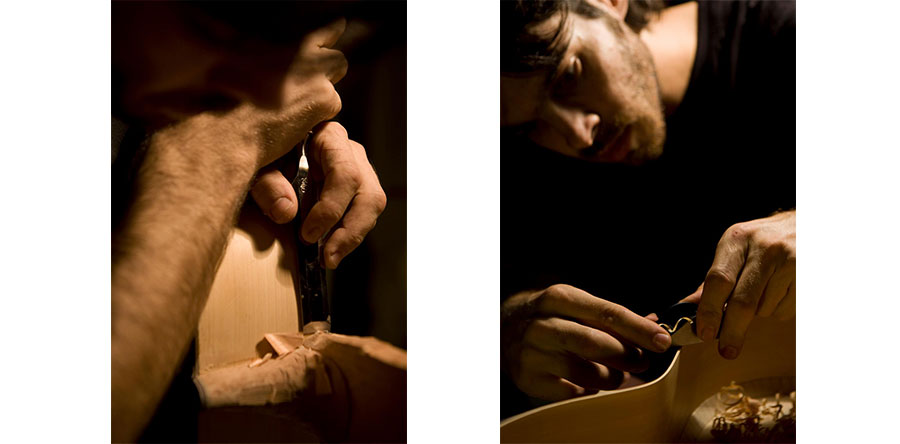Text by Elias Bonet Monné
Photos by Marta Torrent
Hands are Luthier’s most prized tool. Not
only because they shape wooden blocks into a new guitar, but because
hands are our best tool to listen to wood.
When I choose the pieces for a new guitar, I
do numerous tests and assessments using my hands. I hold each piece to
feel the weight; push them to test stiffness; stroke them to hear their
voice with my fingertips; knock on them to discover what is hidden in
their veins. This is why, if I want to know exactly what each piece of
wood can give me, I need to work calmly, taking the time to feel every
grain of the soundboard, discovering the best way to make a cut, or to
strike with a tool.

The craftsman loves to do a good job for
the simple pleasure of a job well done. When the craftsman does not need
the acknowledgment of others, he feels free to work with all his soul,
attentive to every movement he makes, and this is what will ultimately
make him capable of imbuing heart into whatever he does. When it comes
to guitars, there is nothing worse than a guitar without a soul. And it
is impossible to create a soul if the craftsman does not lovingly work
every single piece. Even those pieces that nobody will ever see. Yet he
knows they are there.
But not all guitar makers think the same.
Some prioritise financial gain over and above product quality. Since the
Industrial Revolution the common denominator of all businesses boils
down to: more production plus lower costs equals more competitive
products, and so, the more you sell, the better you are. This pressure
on production erased any peculiarity of individual craftsmen, rendering
them mere tools, part of a production line, working to reproduce
identical objects. Bear in mind that a guitar maker makes an average of
ten instruments per year, that is, high class instruments. The way to
increase this production level is to enrol more people into your
workshop, or to order prefabricated pieces from other workshops. Or even
by commissioning the entire guitar construction abroad. But when that
happens, the craftsman has lost all sense of being a craftsman. His
instruments no longer enjoy Luthier attention. His hands no longer
participate in the guitar-making process. And how could a guitar made in
a factory possibly be imbued with a soul? Obviously this practice is
not wrong, each and every one of us has the right to choose how to
manage our enterprises. In my case, I choose to work alone, making no
more than eight instruments per year. I prefer to work on each and every
process personally. This is the only way to truly know each detail and
virtue, the only way to continue building while bearing every single
peculiarity of every single piece of wood in mind. Working hard, but
calmly in order to give my guitars the soul that they deserve.

Serial made instruments may have correct
sound, but sensitive musicians sense there’s something missing from
them. Feeling the difference between handcrafted and factory made is
something that only sensitive musicians can do. Factory guitars tend to
have very powerful sound, and this is a commonly used trick when selling
guitars to the less experienced. It is very easy to make a loud guitar,
but it is truly difficult to make a sensitive one. A guitar is an
intimate instrument, it is not as powerful as a piano, a violin or a
trumpet; and the louder it is, the less harmonics it can reproduce. The
tone variability of a guitar is defined by its capacity to reproduce the
most harmonics. If a guitar has a wide range of harmonics, the
guitarist will be able to modify the tone when playing, and this
translates into more expression. These musicians are seeking something
very special from inside the guitar. At the end of the day, what a
musician needs is the best tool to help him express all his emotions.
And I ask myself, how can amusician transmit all his emotion to the
audience if the guitar he plays has no soul?
And that’s why there is a new generation of
guitar makers in Spain, that want to make just a few guitars per year,
working unhurriedly, trying to do the best job possible, for the simple
pleasure of doing a good job, because this is precisely what they
believe in: guitars with soul.
Elias Bonet Monné, Luthier
Madrid, the 5th of December 2012



